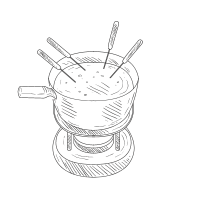How to Keep Fondue Warm: Tips and Tricks for a Perfect Melty Feast
Fondue night: a symphony of melted cheese, rich chocolate, or simmering broth, all waiting to embrace your favorite dippers. But amidst the laughter and conversation, a common challenge arises – how do you keep that fondue pot bubbling with warmth, ensuring every bite is as deliciously gooey as the first?
The Importance of Consistent Fondue Temperature
Picture this: you’ve painstakingly crafted the perfect cheese fondue, a symphony of Gruyere and Emmental, perfectly blended with white wine and a hint of garlic. Your guests are ready to indulge, but as the minutes pass, you notice a tragedy unfolding – the once-velvety smooth cheese has transformed into a clumpy, lukewarm disappointment. The culprit? A drop in temperature.
Maintaining the ideal temperature isn’t just about avoiding a culinary meltdown; it’s about preserving the very essence of the fondue experience. Consistent heat ensures:
* Optimal Texture: Whether it’s the smooth cascade of cheese or the decadent flow of chocolate, the perfect fondue texture hinges on a steady temperature, preventing separation or solidification.
* Enhanced Flavor: Just like a perfectly brewed cup of tea, fondue ingredients release their full flavor potential at the ideal temperature. Keeping it warm unlocks a symphony of taste, from the nutty notes of melted cheese to the rich aroma of dark chocolate.
* Effortless Enjoyment: A warm fondue pot means no awkward pauses for reheating, allowing you and your guests to savor the experience without interruption.
Choosing the Right Fondue Pot for Optimal Heat Retention
Before we delve into the art of keeping fondue warm, let’s address the foundation of a successful fondue night: the pot itself. The material and design of your fondue pot play a crucial role in heat retention, directly impacting your ability to maintain that perfect melt.
1. Ceramic Fondue Pots: Embracing Tradition and Gentle Heat
Ceramic fondue pots, often adorned with charming designs, exude a sense of rustic warmth and tradition. They excel at distributing heat evenly, preventing hot spots that can lead to scorching. While they might take a bit longer to heat up, their heat retention capabilities make them a fantastic choice for leisurely fondue gatherings.
2. Stainless Steel Fondue Pots: Modern Elegance and Efficient Heating
For those who value sleek aesthetics and efficient heat conduction, stainless steel fondue pots are an excellent option. Their durable construction and rapid heating capabilities make them perfect for larger gatherings or when time is of the essence. However, keep a watchful eye, as stainless steel doesn’t retain heat quite as effectively as ceramic, requiring closer attention to temperature control.
3. Electric Fondue Pots: Precision Temperature Control at Your Fingertips
Embracing modern convenience, electric fondue pots provide precise temperature control, eliminating the need for open flames or constant monitoring. With adjustable temperature settings, you can fine-tune the heat to match the specific requirements of your fondue, ensuring optimal consistency throughout your culinary adventure.
Mastering the Art of Keeping Fondue Warm: Proven Techniques
Now that we’ve explored the importance of fondue pot selection, let’s unveil the secrets to maintaining that perfect warm embrace, ensuring a delightful fondue experience from the first dip to the last.
1. Preheating: Setting the Stage for Melty Success
Imagine stepping onto a stage that’s not yet lit – the performance falls flat. Similarly, preheating your fondue pot is crucial for creating a warm and welcoming environment for your ingredients. Whether you’re using a stovetop, electric, or sterno-fueled fondue pot, preheating ensures the pot itself retains heat, preventing a sudden temperature drop when you introduce the fondue.
2. Temperature Control: The Conductor of Your Fondue Symphony
Just like an orchestra requires a skilled conductor to maintain harmony, your fondue needs careful temperature control to achieve culinary perfection. Overheating can lead to scorching, while insufficient heat results in a clumpy, unappetizing mess. Pay close attention to your fondue pot’s heat source:
* Stovetop Fondue Pots: Start with medium heat and gradually reduce it to low once the fondue has reached the desired consistency. Avoid high heat, as it can cause the fondue to stick to the bottom of the pot.
* Electric Fondue Pots: Consult the manufacturer’s instructions for recommended temperature settings for different fondue types. Most electric pots offer adjustable temperature controls, allowing you to fine-tune the heat for optimal results.
* Sterno-Fueled Fondue Pots: These pots rely on the gentle heat of a sterno flame. Ensure the sterno is placed in a well-ventilated area and adjust the flame as needed to maintain a consistent simmer.
3. Stirring: The Key to Even Heat Distribution and a Velvety Texture
Think of stirring your fondue as a gentle dance, encouraging even heat distribution and preventing ingredients from settling or sticking to the bottom of the pot. Use a heat-resistant spatula or fondue fork to stir gently and frequently, especially during the initial heating phase and whenever you notice the fondue thickening or starting to stick.
4. Warm Plates: A Subtle Yet Significant Detail
Imagine transferring a perfectly cooked steak to a cold plate – the rapid temperature drop diminishes the dining experience. Similarly, using warm plates for serving fondue helps retain heat, ensuring each bite is enjoyed at its optimal temperature. Simply run your plates under hot water or briefly warm them in the oven before serving.
5. Tea Lights and Candle Warmers: Extending the Warmth
As the evening progresses and your fondue pot transitions from the main course to a delightful dessert option, consider employing the gentle warmth of tea lights or candle warmers to extend the enjoyment. These elegant solutions provide just enough heat to keep your fondue at the perfect consistency without the risk of scorching or overcooking.
Troubleshooting Common Fondue Temperature Issues
Even with the most meticulous preparations, fondue mishaps can occur. Here’s a handy guide to troubleshoot common temperature-related challenges:
1. Fondue Too Thick: Restoring Flow to Your Culinary Masterpiece
Fear not if your fondue resembles a clumpy cheese dip rather than a velvety smooth indulgence. To thin it out and restore its flow, try these proven techniques:
* Gradual Heat Increase: If using a stovetop or electric fondue pot, gradually increase the heat while stirring constantly to avoid scorching.
* Liquid Addition: For cheese fondue, a splash of warm wine or broth can work wonders. For chocolate fondue, a touch of cream or milk can help restore its silky texture.
* Whisking: Vigorous whisking can help break up clumps and create a smoother consistency.
2. Fondue Too Thin: Achieving the Perfect Viscosity
A runny fondue can be just as disappointing as a thick one. Here’s how to thicken your fondue and achieve the perfect dipping consistency:
* Cornstarch Slurry: Create a slurry by whisking together cornstarch and a small amount of cold liquid (wine, broth, or milk, depending on your fondue type). Gradually whisk the slurry into the fondue and cook until thickened.
* Cheese Grating: For cheese fondue, adding a small amount of grated cheese while stirring constantly can help thicken the mixture.
* Chocolate Addition: In a pinch, adding a small amount of melted chocolate to chocolate fondue can help thicken it up.
3. Fondue Separating: Rescuing Your Culinary Creation
Separation often occurs when fondue is heated too quickly or unevenly. To salvage your separated fondue:
* Gentle Heating: If using a stovetop or electric fondue pot, reduce the heat to low.
* Emulsifier: For cheese fondue, a teaspoon of Dijon mustard acts as an emulsifier, helping to bind the ingredients together. For chocolate fondue, a small amount of soy lecithin can work wonders.
* Blending: For a smooth and homogenous texture, carefully transfer the fondue to a blender and blend on low speed until emulsified.
Beyond Temperature: Additional Tips for a Flawless Fondue Experience
While maintaining the perfect temperature is crucial, a truly exceptional fondue experience extends beyond warmth. Here are some additional tips to elevate your fondue game:
* Dipper Variety: Offer a diverse selection of dippers to complement your chosen fondue. Crusty bread, blanched vegetables, grilled meats, and fresh fruits all make fantastic fondue companions.
* Flavorful Accompaniments: Enhance the flavors of your fondue with an array of dipping sauces and condiments. Consider options like garlic aioli, spicy mustard, cranberry sauce, or chopped nuts.
* Festive Atmosphere: Create a warm and inviting atmosphere with dim lighting, soft music, and lively conversation. Fondue is best enjoyed in good company, making it the perfect meal for fostering connection and creating lasting memories.
As the fondue pot simmers, radiating warmth and inviting laughter, remember that a successful fondue experience is about more than just melted cheese or chocolate – it’s about creating moments of shared enjoyment and culinary delight. By mastering the art of keeping fondue warm and embracing these tips, you’ll be well on your way to hosting unforgettable fondue gatherings that leave your guests craving more.

